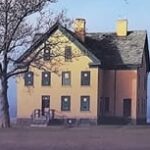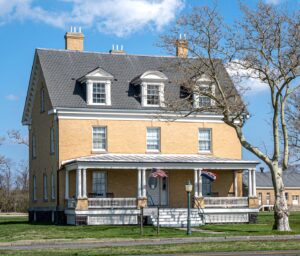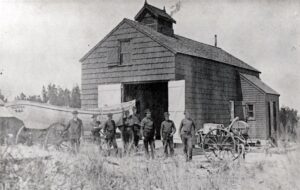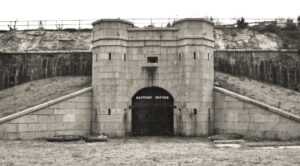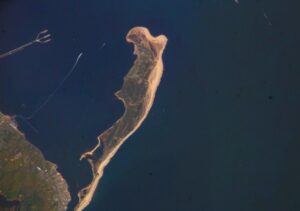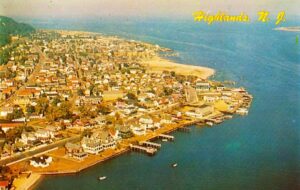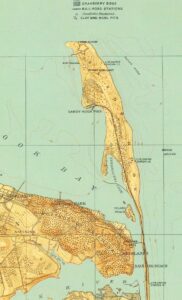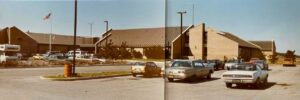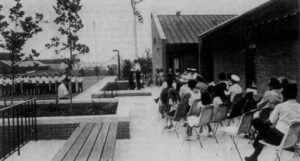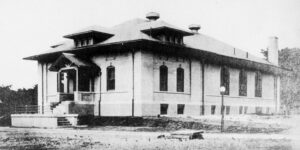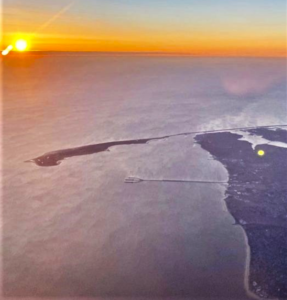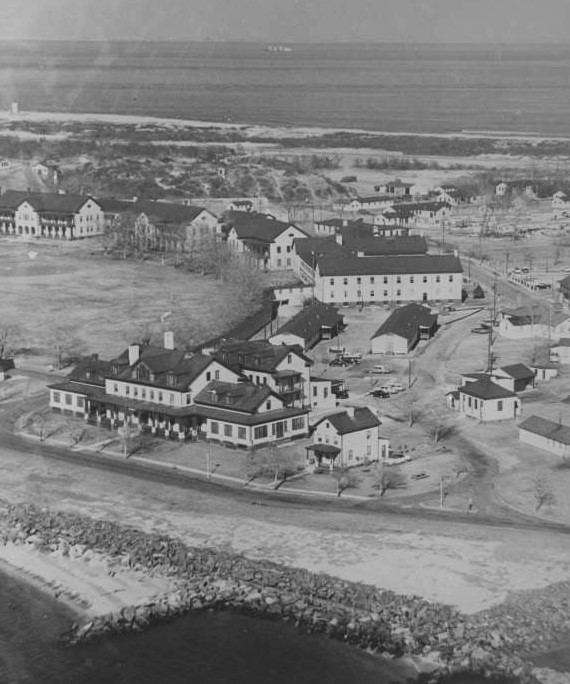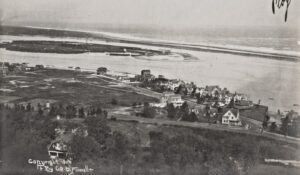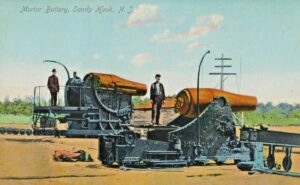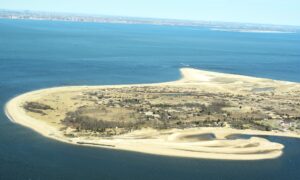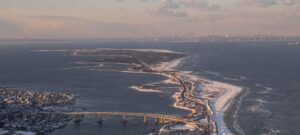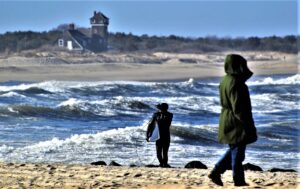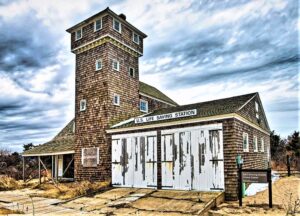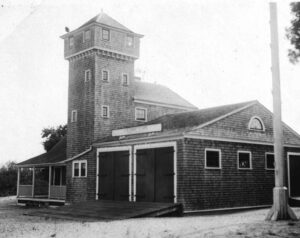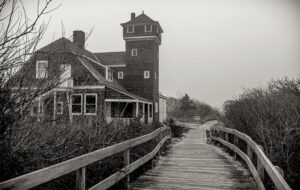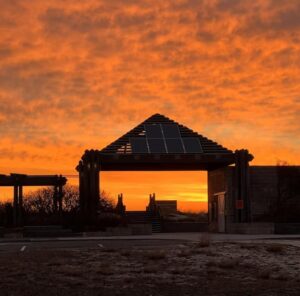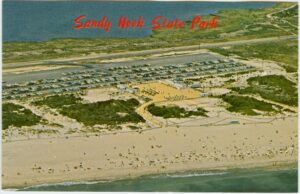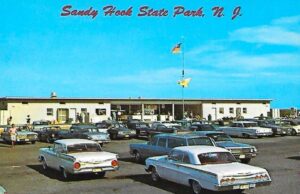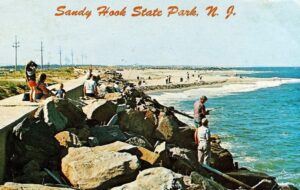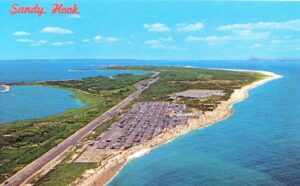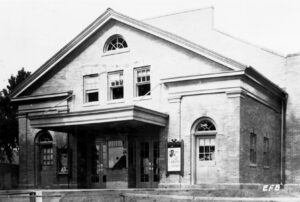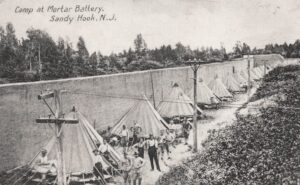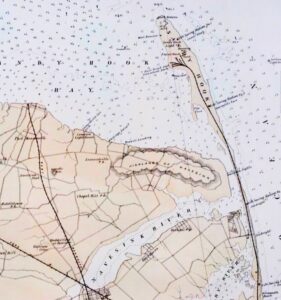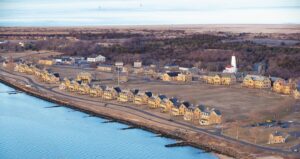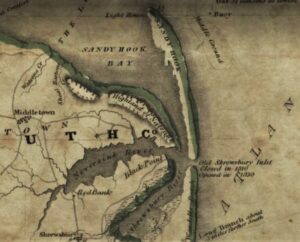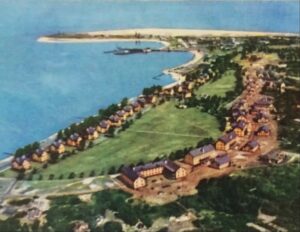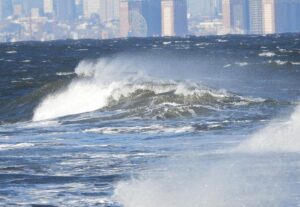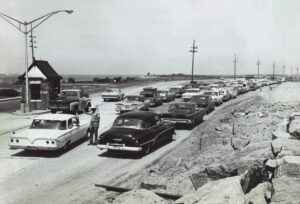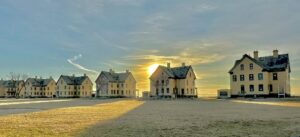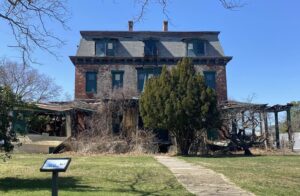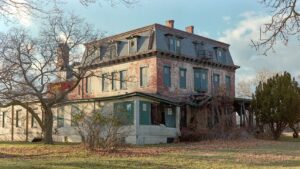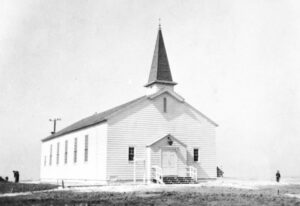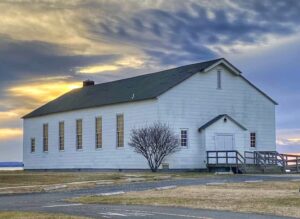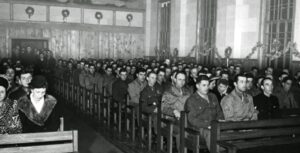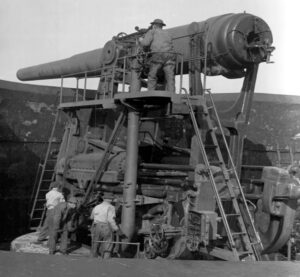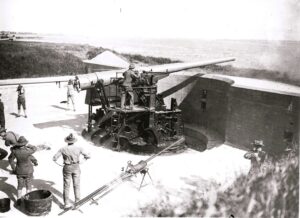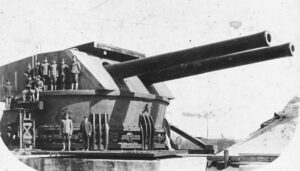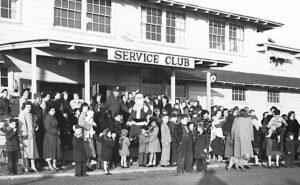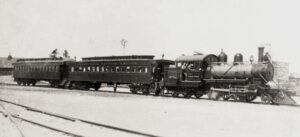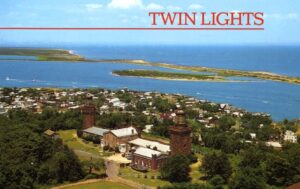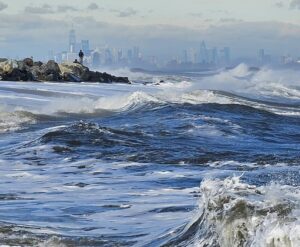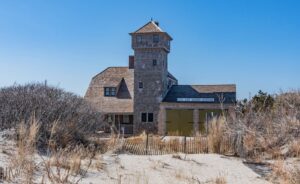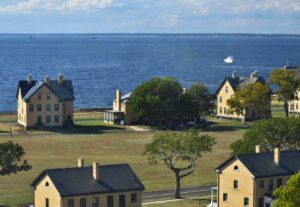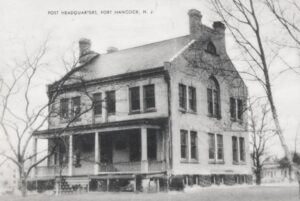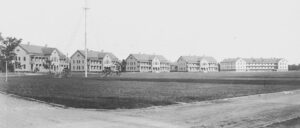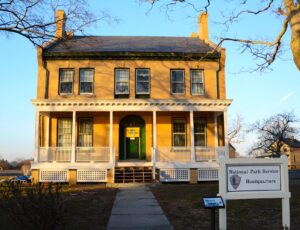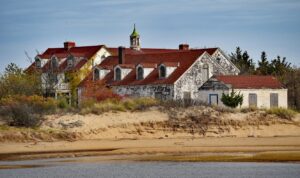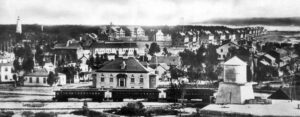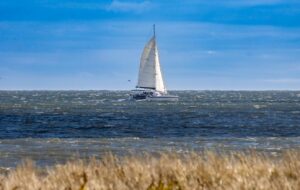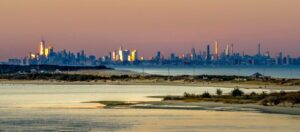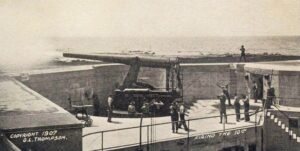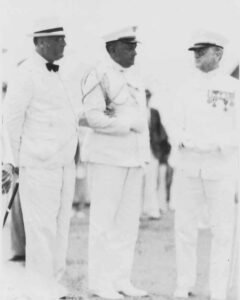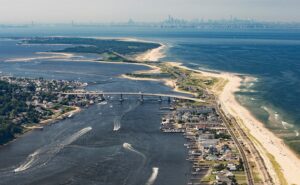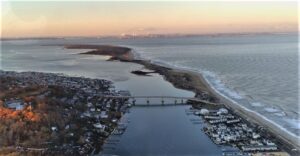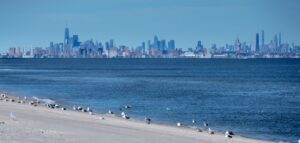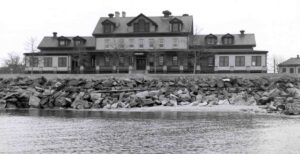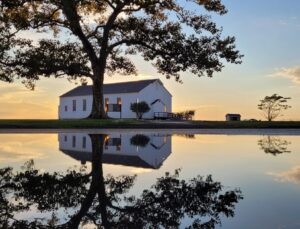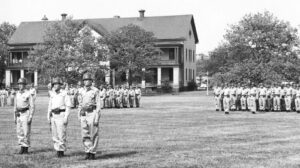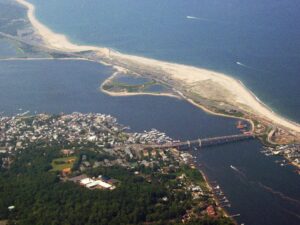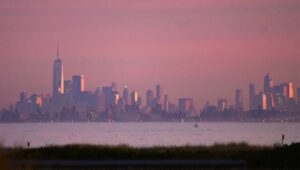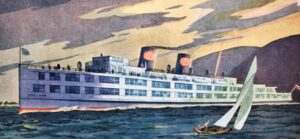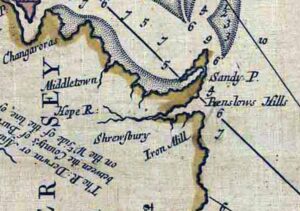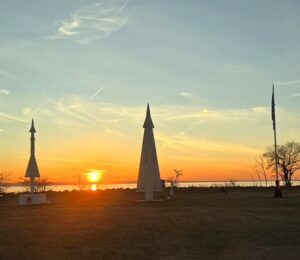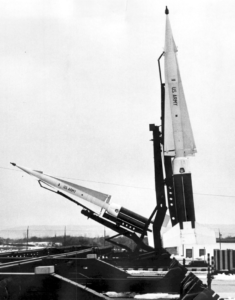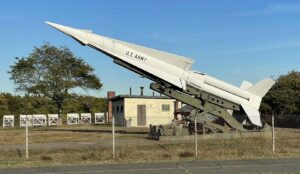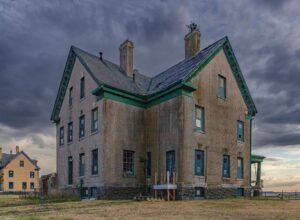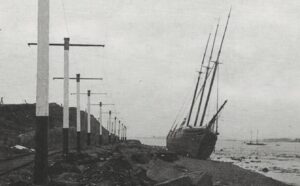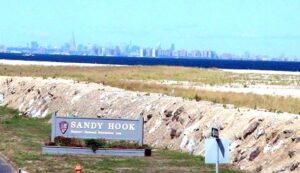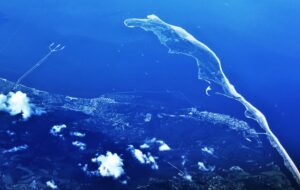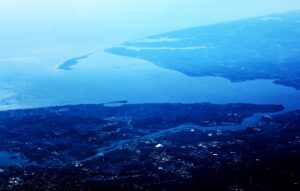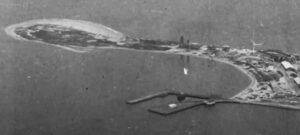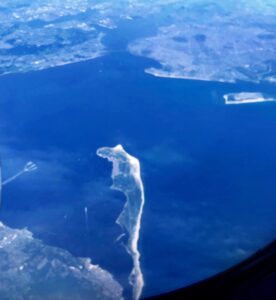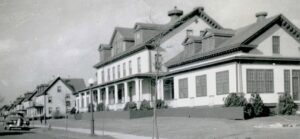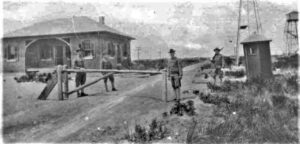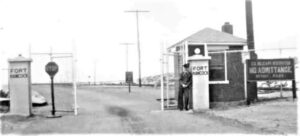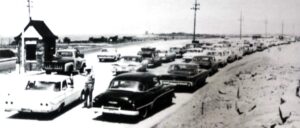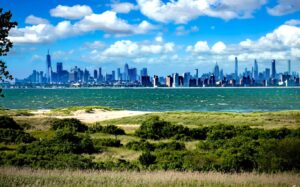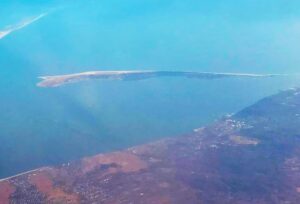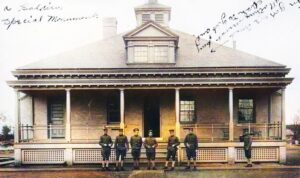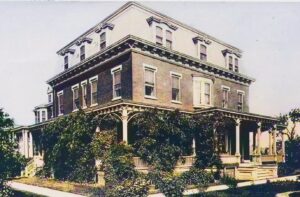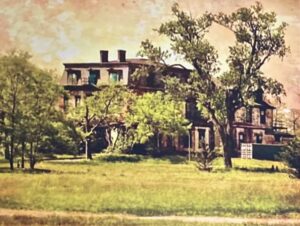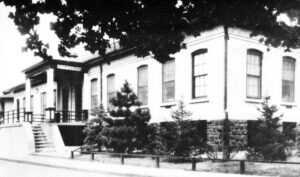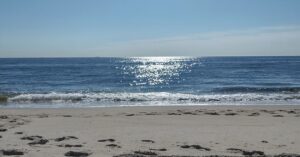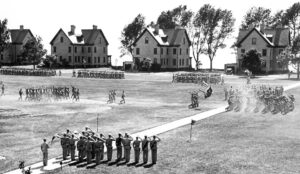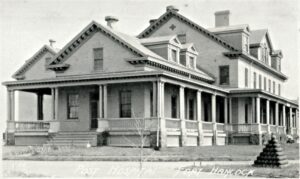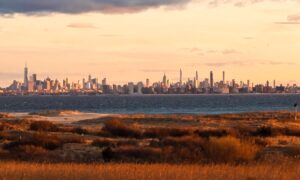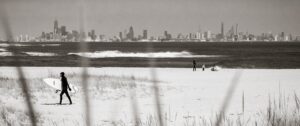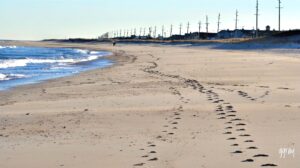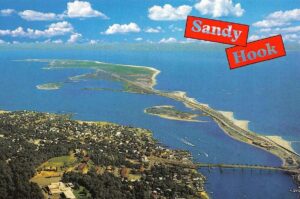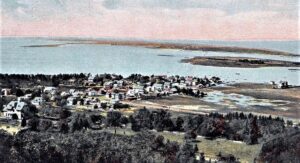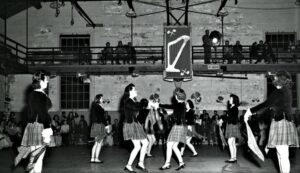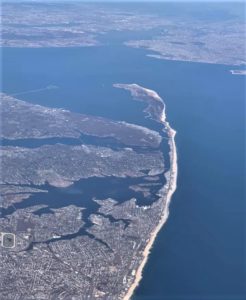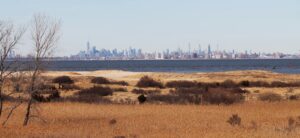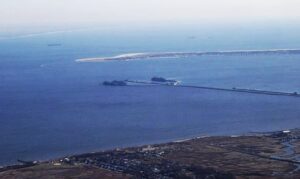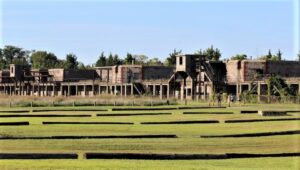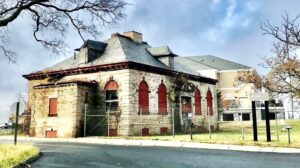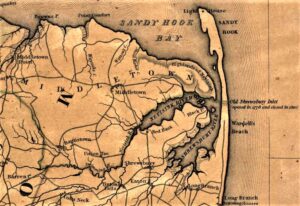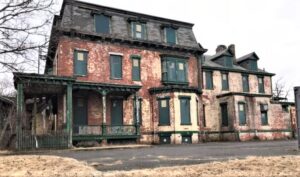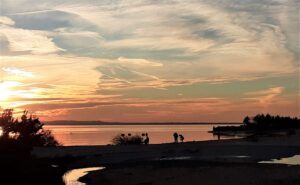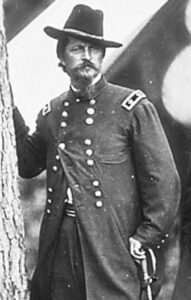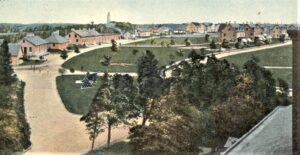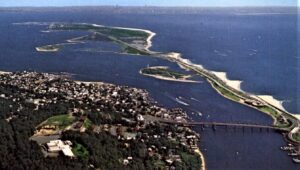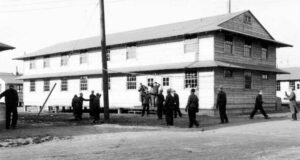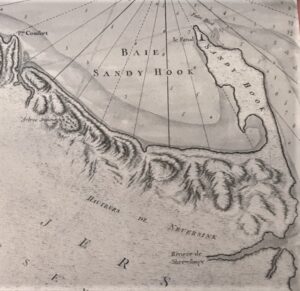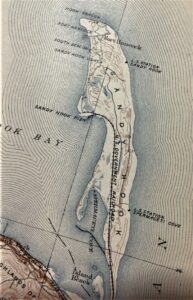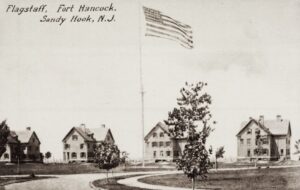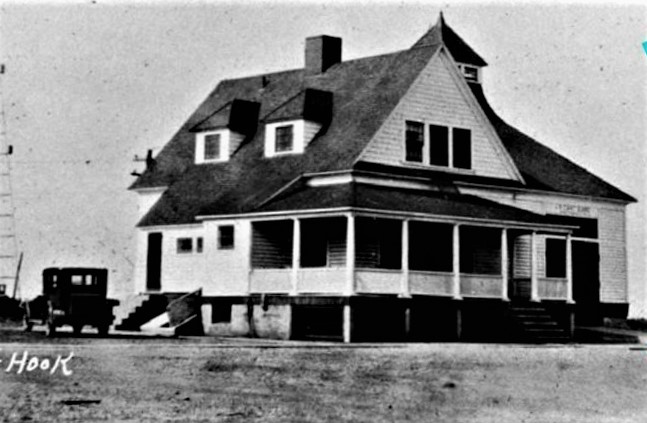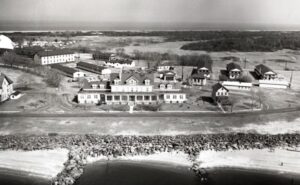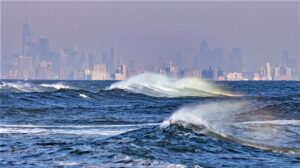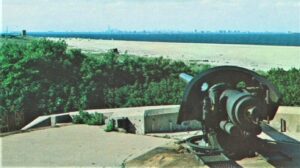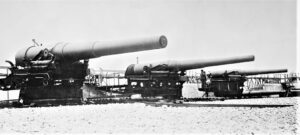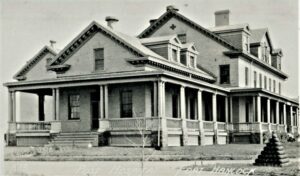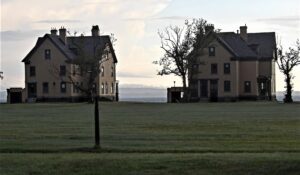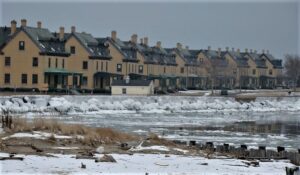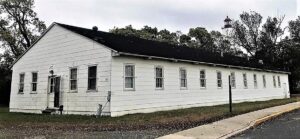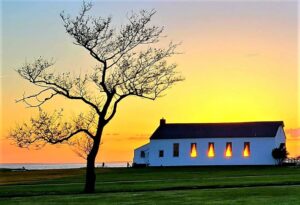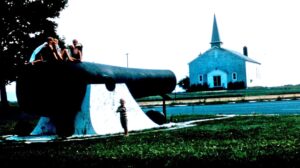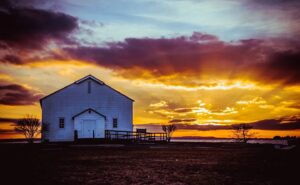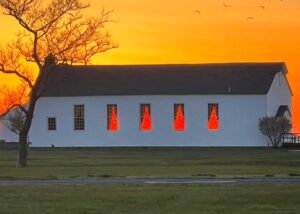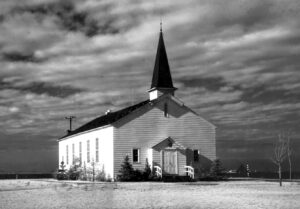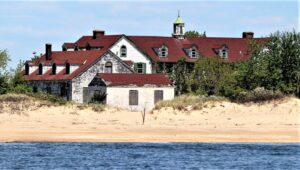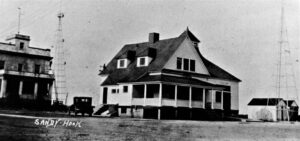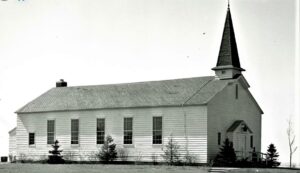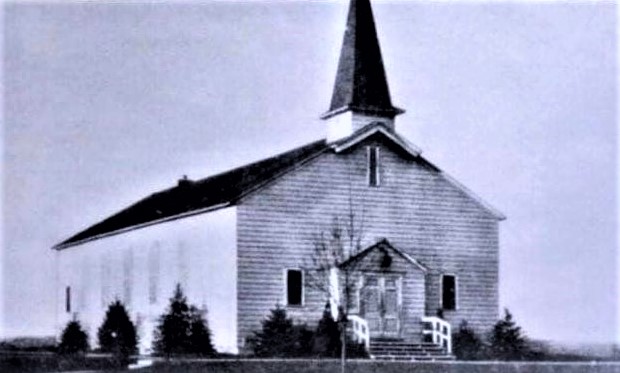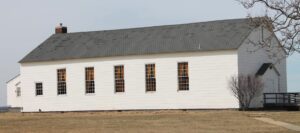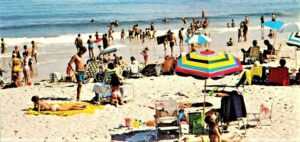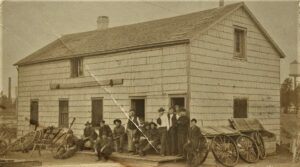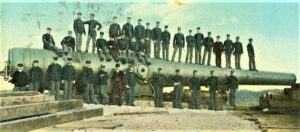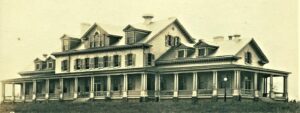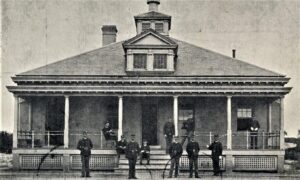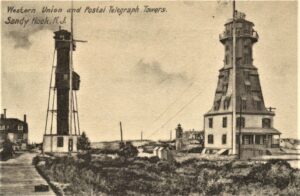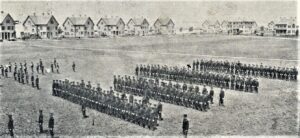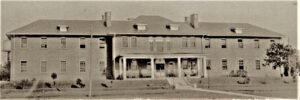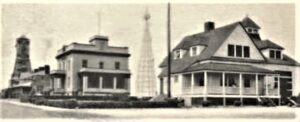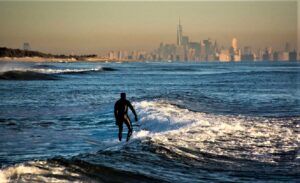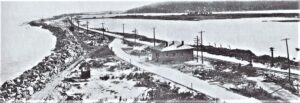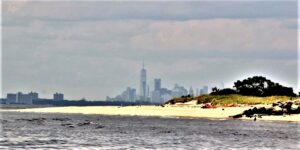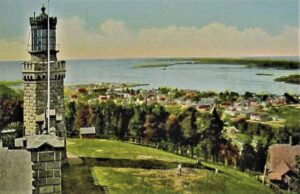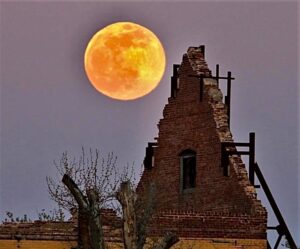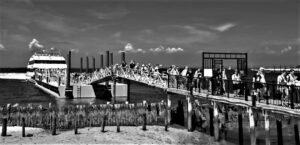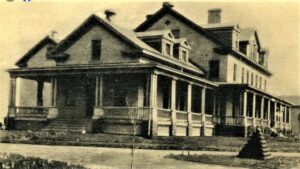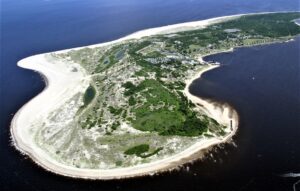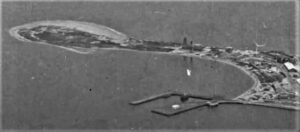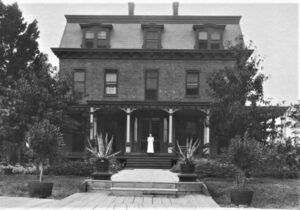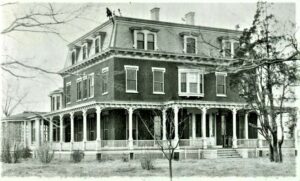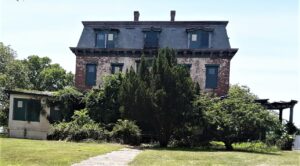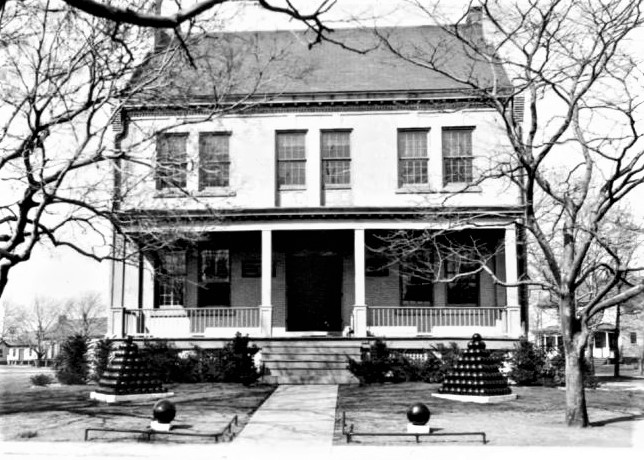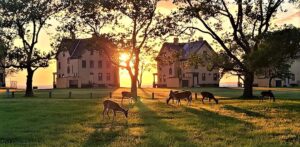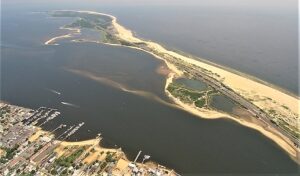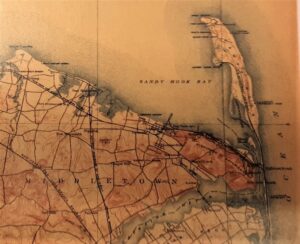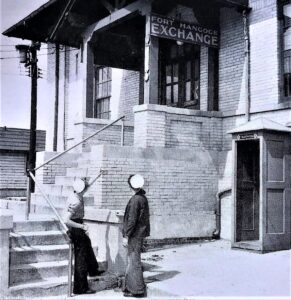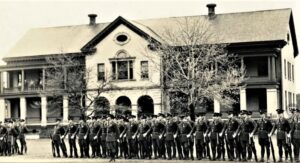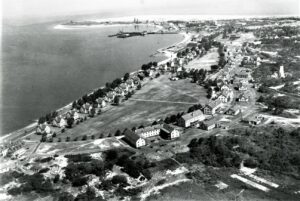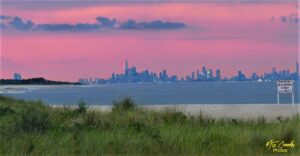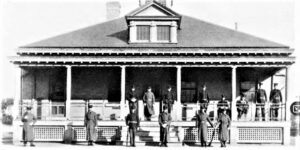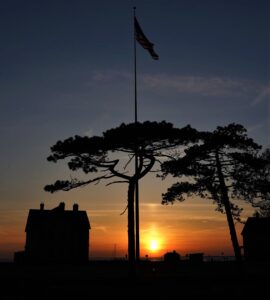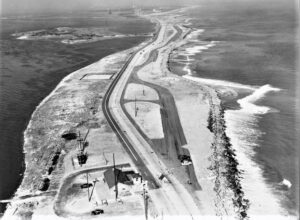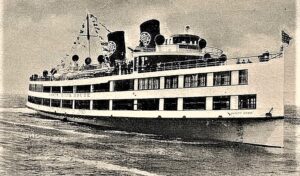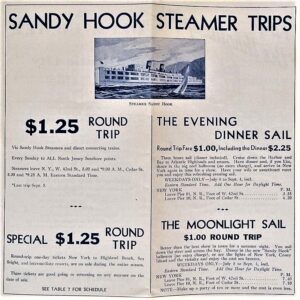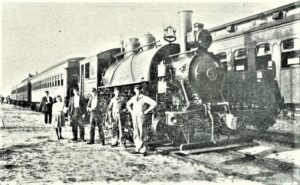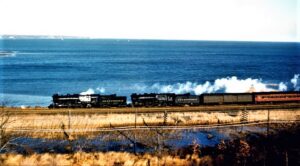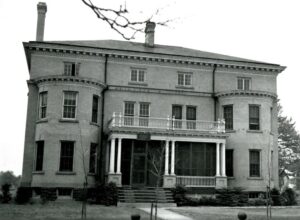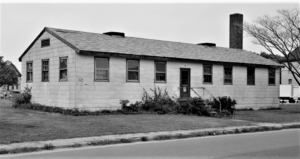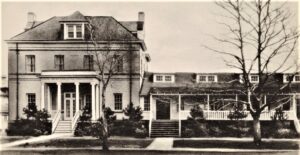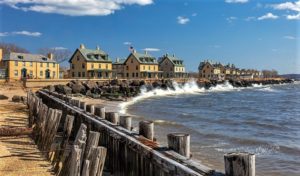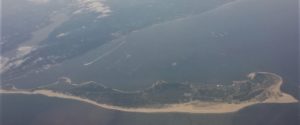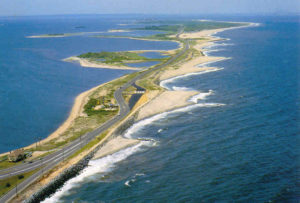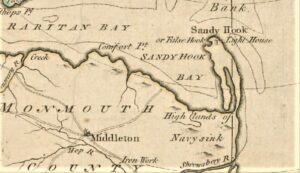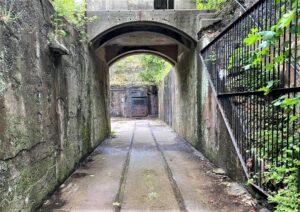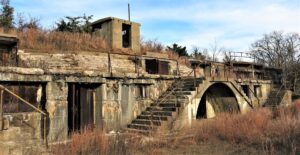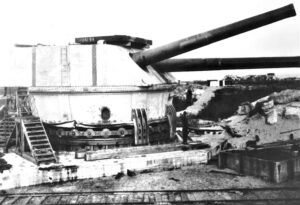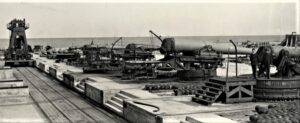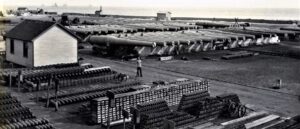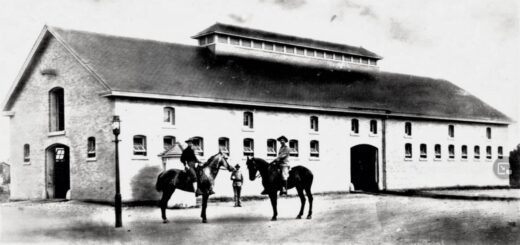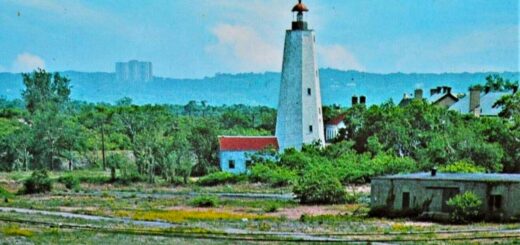Images of Sandy Hook …
It has 500 years of history — going back to the 1520s when Giovanni da Verrazzano became the first European to explore our “Jersey Shore.” In October 1677, Richard Hartshorne acquired much of the Sandy Hook peninsula. By November 1790 the US Congress granted jurisdiction of Sandy Hook lighthouse (and much of the surrounding area) to the federal government.
To me it will always be Sandy Hook. Others know it as Fort Hancock (the US Army and historians) or Gateway National Recreation Area (the National Park Service and 2+ million summer visitors).
I have come to learn that its natural beauty and tranquil atmosphere can cure almost any case of the blues. Have a look at these Sandy Hook images and then go seek some peace for yourself. I’m always searching for more Sandy Hook-related photos and facts, share HERE.
• Sandy Hook Lighthouse Photos — HERE

Smoke & Fire — Gun testing at the Fort Hancock Proving Grounds on Sandy Hook, 1912 (Meredith Wilcox Photo).
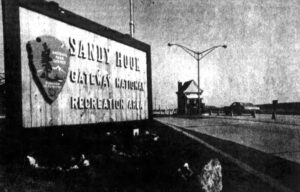
Welcome to Sandy Hook — The change from state park to national park, Red Bank Daily Register, July 1974. The beaches are always free at the national park on Sandy Hook. Only parking fees are charged from Memorial Day to Labor Day (8 am to 6 pm). For summer 2024, public parking is $20/day or $100/season.
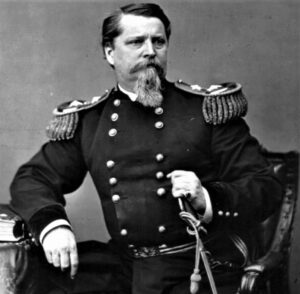
The Very Model — Major General Winfield Scott Hancock, for whom the US Army post was named in October 1895. Gen. Hancock served heroically during the July 1863 Battle of Gettysburg.
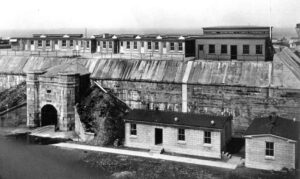
True Solider — Mortar Battery Potter at Fort Hancock, during WW II (Stanley Kosinski Photo). Named to honor General Joseph H. Potter, who served gallantly in the Union Army during the Civil War. Talk about commitment to duty: Potter was twice captured, twice exchanged, and twice returned to arms.
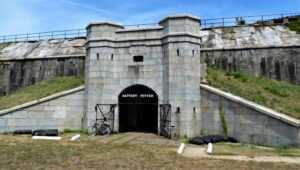
Battery Potter entrance, 2010. A New Hampshire native and 1843 West Point classmate of U.S. Grant, Potter died in 1892.
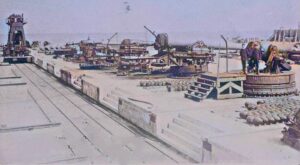
Battery Proving Grounds platform on Sandy Hook, late 1890s. Ordinance operations were ultimately moved to Aberdeen, Maryland.
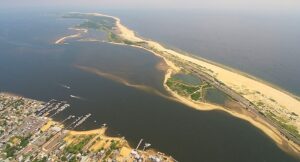
All the Way — Sandy Hook aerial image, Spring 2021 (John Schneider Photo). Spermaceti Cove on the Hook’s west side was named for a beached whale there in 1688.
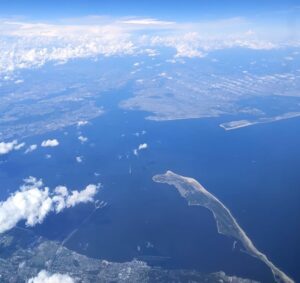
Over & Above — Sandy Hook aerial image, January 2024 (Luis Carvalho Photo). Offshore MB • LB • SB from a hydrographic perspective is “not complex. The formation resembles a plateau extending seaward 85 miles from the shoreline and gently sloping to 300 feet below sea level. Beyond that the depths increase precipitously, attaining 6,000 feet about 100 miles from the shore,” History of New Jersey Coastline by C. F. Wicker, 1950 — MORE INFO.

Sandy, City & Surf — Sandy Hook shoreline, December 2023 (Richie Tomppert Photo).
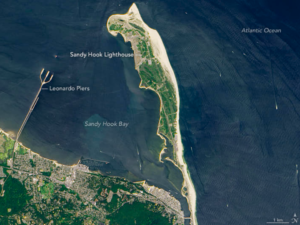
Big Picture — Sandy Hook aerial image, 1990s. The long pier is from US Naval Weapons Station Earle. Construction began in August 1943 and it’s still an active military installation. Basically, it’s a safe-distance munitions loading depot for any US Navy warship. Considered one of the world’s longest “finger piers” — its length is nearly 3 miles.
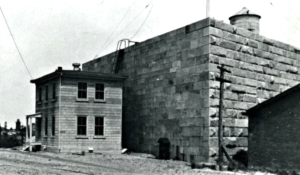
Lost & Found — Remains of the original five-sided granite fort at Sandy Hook, begun in the 1859. Robert E. Lee — then a US Army Corps of Engineers captain — was responsible the fort’s initial design in 1850.
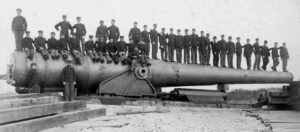
Big Shot — Fort Hancock coastal defense gun — “biggest in the world,” 1903. Weight: 284,000 pounds. The M1895, 16-inch weapon had a firing range of 12 miles.
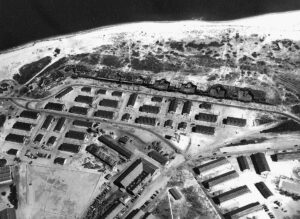
Fire Power — Nine Gun Battery at Fort Hancock on Sandy Hook aerial image, 1942 (John Schneider Photo). The US Army began construction in 1897 and when completed in 1904, it was the longest gun battery ever built for harbor defense.
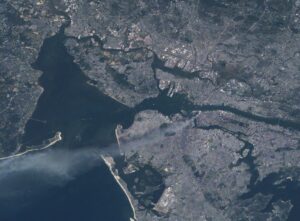
Under Attack — Sandy Hook area, September 11, 2001. Smoke billows from lower Manhattan after the twin towers were wrecked.
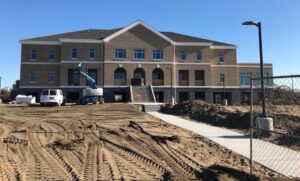
Bigger & Better — The new US Coast Guard Station at Sandy Hook under construction, 2017. The $54 million state-of-the-art federal marine facility opened in July 2018. The 20,300-square-foot structure is 14 feet above the floodplain and can withstand a Cat 3 storm.
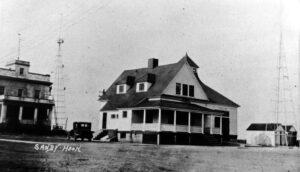
Old Guard — The USCG Station at Sandy Hook, 1930. It was mostly wrecked during Superstorm Sandy in 2012.
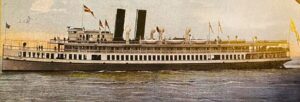
Super Ship — SS Sandy Hook, 1900. Built in 1889 by the Central Railroad of New Jersey for passenger service between NYC and the Jersey Shore. The 270-foot-long steamship (with ballroom and dining salon) was wrecked in 1951.
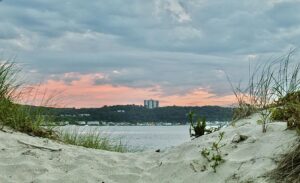
Real Highlands — “The Eastpointe” high-rise in Highlands seen from Sandy Hook, July 2023 (Bella Beachy Photo). Opened in 1975, the 14-story condo rests at the Atlantic seaboard’s highest natural point.

Superior Seascape — Sandy Hook, June 2023 (Henryk M Photography).
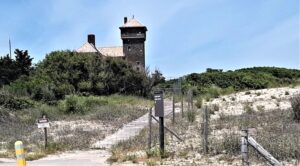
US Life-Saving Service Station on Sandy Hook, June 2021. Opened in 1894 as Spermaceti Cove #2. This Duluth-style building on Sandy Hook would later be a US Coast Guard station from 1915 to 1946. It was the National Park Service Visitor’s Center and museum from 1974 until Superstorm Sandy damages in 2012. It’s been rehabbed.
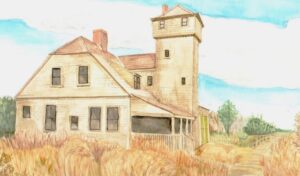
US Life-Saving Service Station sketch, 2023 (Sandy Hook Foundation Photo). Revered as heroes of the Atlantic Coast, the surfmen’s motto was “you have to go out, but nothing says you have to come back.”
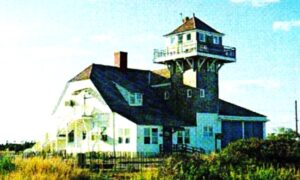
US Life-Saving Service Station on Sandy Hook (USLSS Heritage Association Photo). Using equipment like the beach-apparatus cart, lifeboat, Lyle Gun and breeches buoy, life-saving crews risked their lives in dangerous maritime rescues.
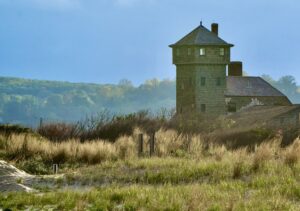
Old US Life-Saving Service Station, Spring 2023 (Sandy Hook Foundation Photo).
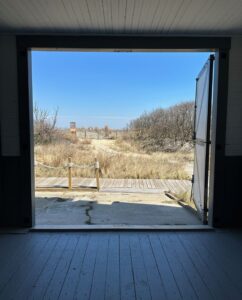
Look Out — View from the old US Life-Saving Station on Spermaceti Cove, April 2023. The Sandy Hook Foundation recently host its popular “Spring Soiree” there.
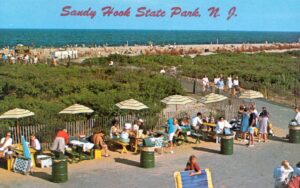
Sandy Hook State Park, 1960s postcard. After opening in July 1962, the coastal park quickly became the state’s most visited. Daily admission was 25 cents.
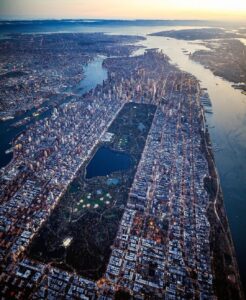
Big Picture — NYC’s Manhattan Island looking south, March 2023 (HDK Photography). At the very top of the photo is the faint image of Sandy Hook, NJ.
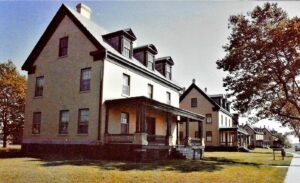
Old Fort Hancock Officer’s Row on Sandy Hook, 1976 (Gary Becker Photo).
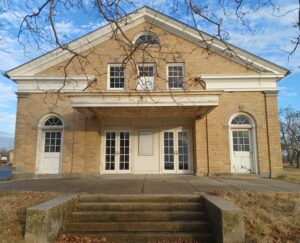
Old Post Theater at Fort Hancock on Sandy Hook, December 2021 (Kevin Saunders Photo). Opened in 1933, it seated 300 soldiers.
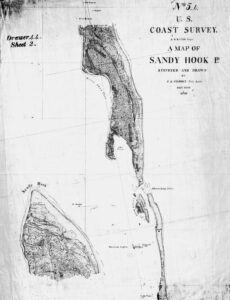
Sandy Hook coast survey map, December 1848. When Richard Hartshorne first acquired Sandy Hook in 1692 it was just 200 acres; it’s grown to over 2,000 acres now.
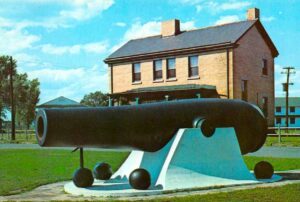
Rodman Gun on display at Sandy Hook, 1970s postcards. The 115,000-pound canon went operational in 1869.
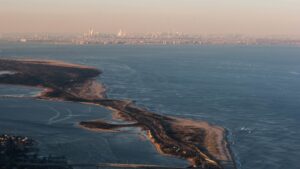
All the way out — Sandy Hook, 2020s (Avicorp Capital Aviation Photo).
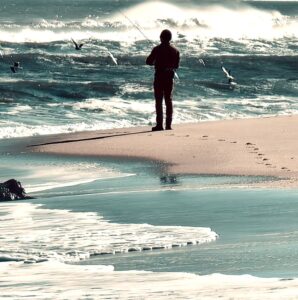
Fishing on Sandy Hook, Winter 2023 (Sean Kelly Photo). Fishing Reports from Sandy Hook — HERE.
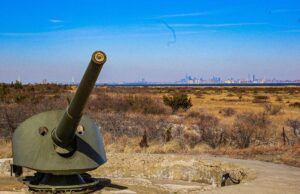
Old Guard — This US Army gun battery on Sandy Hook once protected NYC, Winter 2023 (Melissa Mohr Photo).
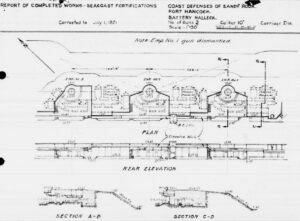
Design plans for Battery Halleck at Fort Hancock, 1900. Named to honor Civil War Major General Henry W. Halleck, the three-gun, 10-inch disappearing battery operated until 1942.

“Sandy Hook Foghorn” newspaper banner, August 1943. The official Fort Hancock weekly was managed by fort soldiers.

Fort Hancock Officer’s Club on Sandy Hook, April 1938. Completed by the US Army in 1879, the 12,000-square-foot structure still stands today.

Fort Hancock Officer’s Club sketch proposal, July 1878 (National Park Service). From 1919 to 1935 it was a US Army officer’s quarters.
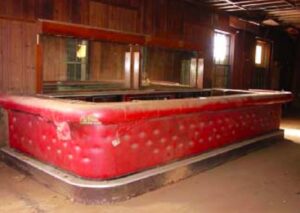
Fort Hancock Officer’s Club bar, 2005 (National Park Service).

Fort Hancock Officer’s Club, 1900 (National Park Service). Also called the “Brick House” — it’s the second oldest stone structure on Sandy Hook (after the lighthouse) MORE INFO.
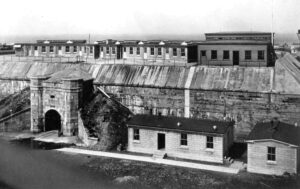
Battery Potter at Fort Hancock on Sandy Hook. Construction began in 1890 and the guns went silent in 1906.
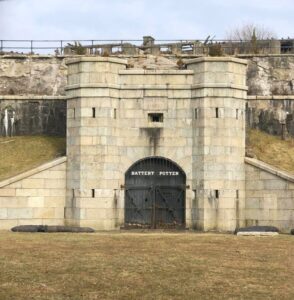
Battery Potter at Fort Hancock, 2022. Named for Brigadier General Joseph H. Potter in March 1903, the nation’s first disappearing gun battery was powered by a steam hydraulic-lift system.
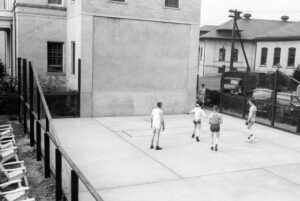
Handball Court at Fort Hancock on Sandy Hook, 1940s (Sandy Hook Foundation Photo).
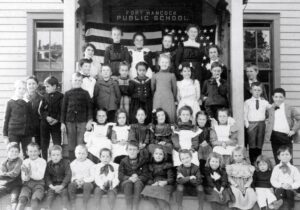
Fort Hancock Public School on Sandy Hook, 1920s (Sandy Hook Foundation Photo).

Fort Hancock Baseball Team, early 1900 (Sandy Hook Foundation Photo).

Early times for the US Army at Fort Hancock, 1910s. Sandy Hook’s role in defending America’s top port officially ended in August 1974.
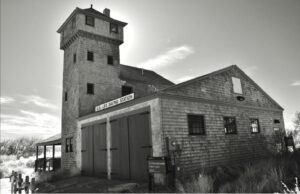
Old US Life-Saving Station on Sandy Hook, November 2021 (Joe Paduano Photo). Built in 1894 along Spermaceti Cove, it was the National Park Service Visitor’s Center before Superstorm Sandy damage in October 2012.
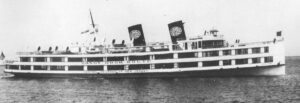
SS Sandy Hook, 1930s. The 2,000-passenger capacity steamship was built by the Central Railroad of New Jersey in 1889 for service between NYC and the Jersey Shore. It was scrapped in September 1951.

Sandy Salute! — Sandy Hook became a National Historic Landmark in December 1982. Officially, it’s the “Fort Hancock and Sandy Hook Proving Ground Historic District” and is one of 58 such in NJ MORE INFO.
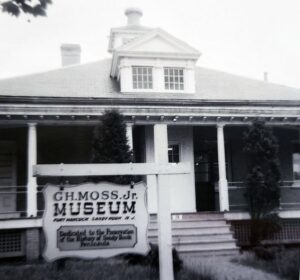
George H. Moss, Jr. Museum at Fort Hancock on Sandy Hook, 1969 (Paul McLeod Photo). George was a very sharp and savvy guy. During World War II, he had been a cryptographer for the OSS (i.e., a code-breaker for the CIA).
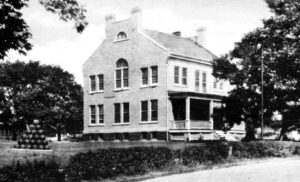
Fort Hancock Post Headquarters, 1939 (Sandy Hook Foundation Photo). Also called the “Administration Building,” it opened in July 1899 and still stands today.
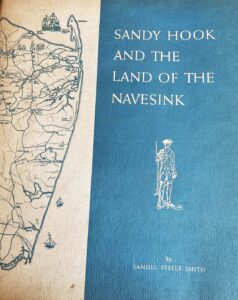
“Sandy Hook and the Land of the Navesink” by Samuel S. Smith, 1963. MORE INFO.

Post Chapel at Fort Hancock on Sandy Hook, 1941. Fort commanding officer Brig. Gen. Philip S. Gage (he had roomed with George Patton at West Point) opened the new army house of worship in December 1941. According to his 1982 New York Times obit, emphasizing the fort’s strategic importance, General Gage said: ”We are the gatekeepers of America’s front door.”
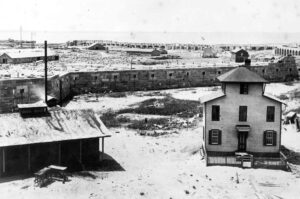
Old Fort Hancock on Sandy Hook, early 1900s (John Schneider Photo). Fort Hancock was created in response to America’s increased need for harbor defense installations, according to NPS history. Although the order to build the Sandy Hook fort was issued in 1895, the post’s first garrison of US Artillery Corps troops did not arrive until March 1898 to man the gun batteries protecting New York Harbor.
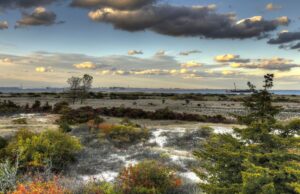
All the colors — a fabulous fall day on Sandy Hook, October 2022 (MAC Photography).
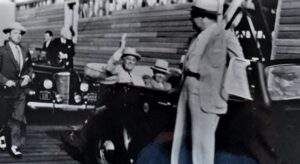
President Franklin D. Roosevelt arrives at Fort Hancock having disembarked the USS Lang, August 1939. From Sandy Hook a motorcade took FDR to the Red Bank train station and on to Washington, DC. He’d been on a fishing trip in Canada. Despite the happy greeting, legend is the president was shaken upon arrival after learning of the infamous Hitler-Stalin nonaggression pact — sometimes called “the kick-off to World War II.” (Beth Woolley Photo).
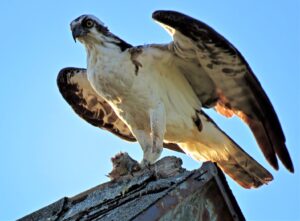
An Osprey atop an old Sandy Hook building, 2021. Also known as the “fish hawk” — the osprey is one of New Jersey’s largest raptors, according to the American Littoral Society. These magnificent birds of prey — once threatened in 1960s North America from pesticides — have been able to recover. Some 325 species of birds stop by Sandy Hook annually.

Western Union Telegraph Company, Postal Telegraph Cable Company, Weather Bureau, and US Life-Saving Station on Sandy Hook, 1910.
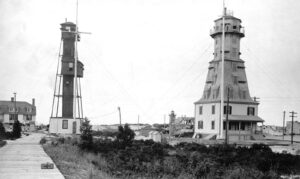
Watch towers of the Western Union Telegraph Company and Postal Telegraph Cable Company on Sandy Hook, 1910s.

US Army on the Fort Hancock Parade Grounds, early 1900s (Stanley Kosinski Photo).
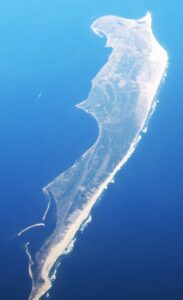
End to End — Sandy Hook aerial image, 2022. A natural barrier spit, Sandy Hook is 6.5 miles long and up to 1 mile wide. It covers 2,044 acres.
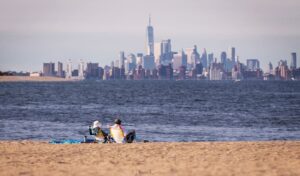
Metropolis in Sight — A couple gets a NYC-skyline view from a quiet Sandy Hook beach, Sept. 2022 (David Kaston Photo).
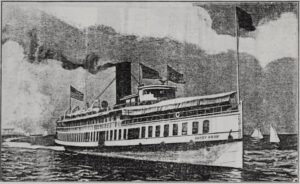
SS Sandy Hook sketch, 1923. The Central Railroad of New Jersey built this 2,000-capacity steamship in 1889 for passenger service between New York City and the Jersey Shore. Once considered “a glamour girl,” it was scrapped in September 1951.
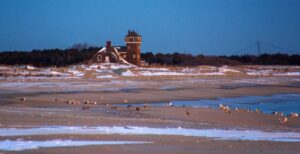
Old US Life-Saving Service Station #2 on Sandy Hook with the tip of the Verrazzano-Narrows Bridge visible in the distance, (Stanley Kosinski Photo), 2022. Built in 1894 on Spermaceti Cove, it also housed the Sandy Hook Visitor’s Center until wrecked by Superstorm Sandy in 2012.
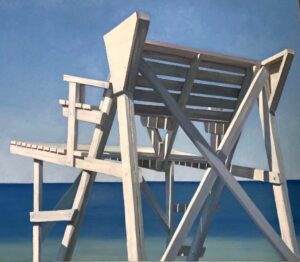
“Sandy Hook Lifeguard chair,” Summer 2022. Painting by Gregory Lewis.
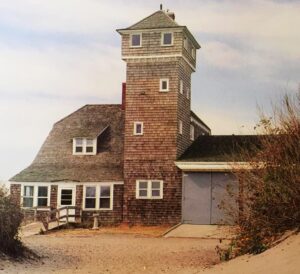
US Life-Saving Service Station on Sandy Hook, 2000s. Called Spermaceti Cove #2, it opened in 1894. It was also a US Coast Guard station from 1915 to 1946. It was the National Park Service Visitor’s Center from 1974 until major damage by Superstorm Sandy in 2012.
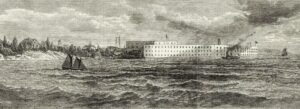
“The new fort near Sandy Hook at the entrance to the Bay of New York,” April 1865. (NY Public Library Picture Collection).
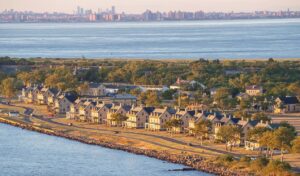
Old US Army Officer’s Row along Sandy Hook Bay, 2022 (StansPhotos).
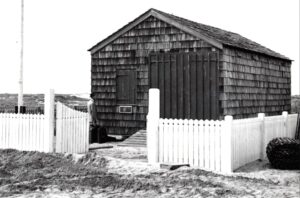
US Life-Saving Service shack on Sandy Hook, 1940s. Built in 1849, it was the first in the nation of its kind.
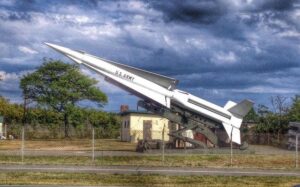
Old NIKE Missile, 2022. “Guardian Park” on Sandy Hook commemorates the Nike Missile Air Defense Era.
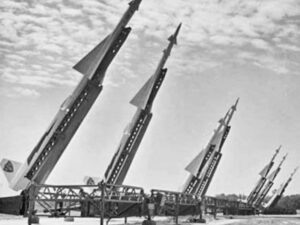
Ajax missiles in ready position at Fort Hancock on Sandy Hook, 1958. It was part of the New York Air Defenses — Nike Batteries that ringed New York City.
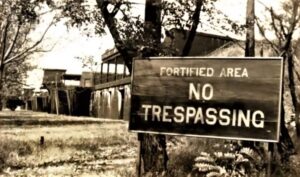
Fort Hancocok “No Trespassing — A great deal of the activities at the US Army base were top secret and highly classified.
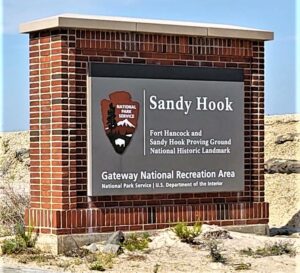
Sandy Hook entrance, 2020 (Thomas Minton Photo). Our national park at the beach — is officially Gateway National Recreation Area.
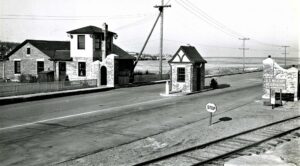
Old Fort Hancock entrance gate, 1942. Started as the “Fort at Sandy Hook” in 1857, it was never completed. Unofficially it was called “Fort Lincoln” and “Fort Hudson” by the locals — before officially becoming Fort Hancock in 1895.
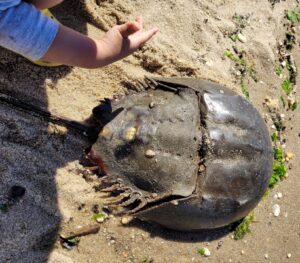
Atlantic horseshoe crab (Limulus polyphemus) on Sandy Hook, June 2022. These odd marine arthropods have been on Earth for about 450 million years.
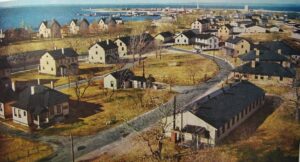
View from Sandy Hook Lighthouse, 1953. The US Army official decommissioned Fort Hancock in December 1974.
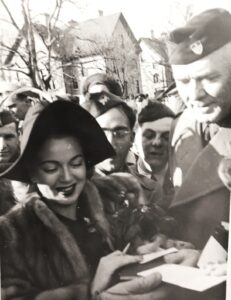
Movie star Lana Turner during a good-will tour of Fort Hancock with the post CO Brigadier General Phillip Gage (r), November 1941 (Bernard Duze Photo). The 5,000 US Army solders on Sandy Hook voted her “Sweetheart of Sandy Hook.”
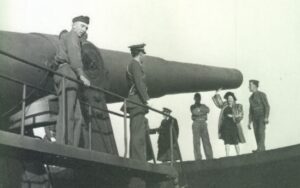
Big Shot — During her visit to Fort Hancock the film star got a tour of an obsolete gun battery, November 1941.

Lana Turner (1921-1995). This small-town girl from Idaho became one of the highest-paid actresses in her prime and one of MGM’s biggest star. She also married seven times.

Fort Hancock, NJ., 1930s. Amidst “Officer’s Row” you’ll see two lighthouses in the image. At left is the granddaddy of them all, the “Sandy Hook Lighthouse” (still operating and America’s oldest). In the center is “Little Red Lighthouse.” Built in 1880, it reached 40-feet-high; it was removed in 1917.
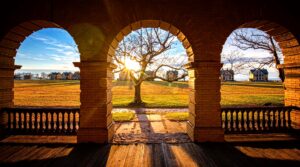
“Hook Look,” March 2022 (Meg Fisher Photo).

Fort Hancock Officer’s Row house, March 2022. One of 18 buff-brick US Army officer’s quarters built along Hartshorne Drive from 1898-1899. After first scouting the area in 1896, Captain Arthur Murray was later credited for the overall layout and architectural design.

SS Sandy Hook, 1930s. The steamship was built in 1889 by the Central RR of New Jersey for passenger service between New York City and the Jersey Shore. After a fire in 1931, it was rebuilt and returned to service. It was sold for $35,000 in scrap in September 1951.
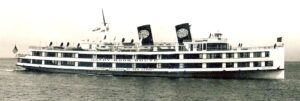
SS Sandy Hook, 1920s. According to a June 1946 Long Branch Daily Record story about its end of service, the vessel transported over 15 million passengers (and at least two US Presidents) from 1889 to 1941. With a capacity of 2,000, it was considered New York Harbor’s fastest and finest steamer — “a glamour girl.” The 270-foot-long boat — with ballroom and dining salon — cost $235,000 to build.
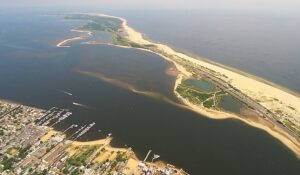
A grand view of Sandy Hook Bay, 2021 (John Schneider Photo). Below is the bayshore Borough of Highlands — incorporated in 1900, it has about 5,000 residents.
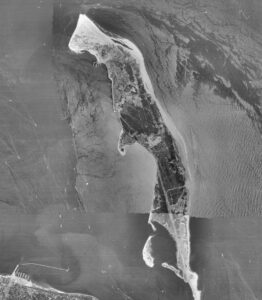
Sandy Hook peninsula satellite image, 1970 (John Schneider Photo). It’s about 6.5 miles to the tip.
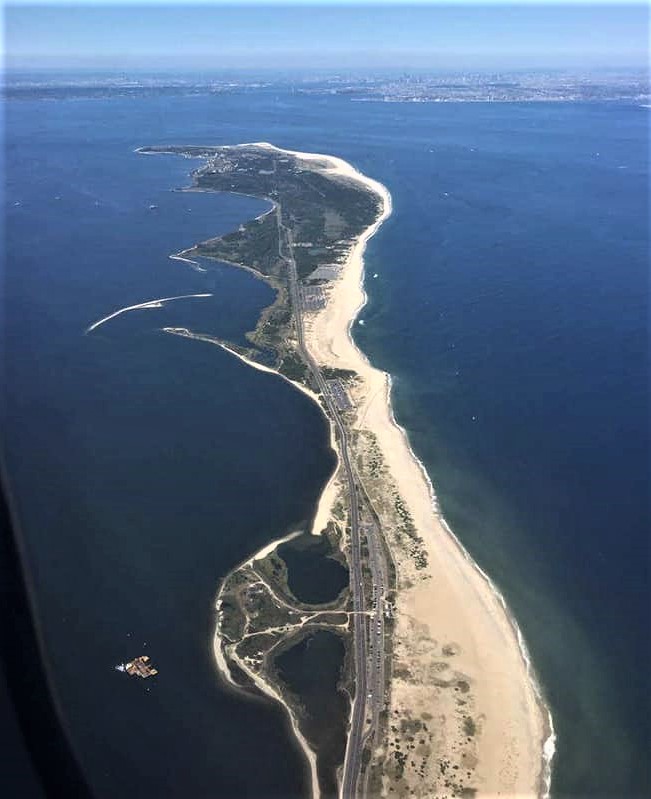
Sandy Hook aerial image, 2022. Henry Hudson, a British explorer working for the Dutch, first anchored his ship the Half-Moon in Sandy Hook Bay In September 1609.
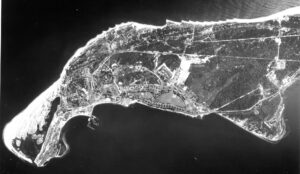
“Confidential” aerial photo of Fort Hancock as it readied for a world war, September 1940 (John Schneider Photo).
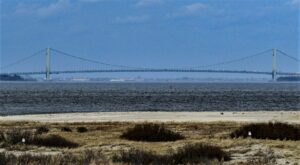
The Verrazzano-Narrows Bridge seen from Sandy Hook, 2022. When the span opened in 1964 the toll was 50 cents; today it’s $17.
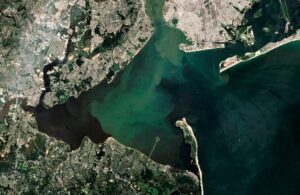
Sandy Hook and Lower New York Bay. The Gateway National Recreation Area — spanning 27,000 acres including parts of New Jersey and New York City – is the gateway from the ocean into New York Harbor. Besides the Sandy Hook Unit is the Staten Island Unit (with Fort Wadsworth, Miller Field, and Great Kills Park) and the Jamaica Bay Unit (with Floyd Bennett Field, Shirley Chisholm State Park, Jamaica Bay Wildlife Refuge, Canarsie Pier, Breezy Point, Fort Tilden and Jacob Riis Park). Created in October 1972, more than 9 million visitors come to this urban oasis annually.
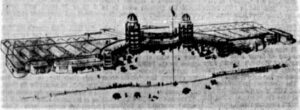
Sandy Hook State Park Authority sketch proposal for a new main bathhouse and restaurant, Long Branch Daily Record, July 1951.

General Hancock during Civil War years, 1861-1865. He was the 1880 Democratic candidate for US President and was nearly elected. He lost to James Garfield by just 10,000 votes out more than 9.2 million cast nationally; but he did carry New Jersey.
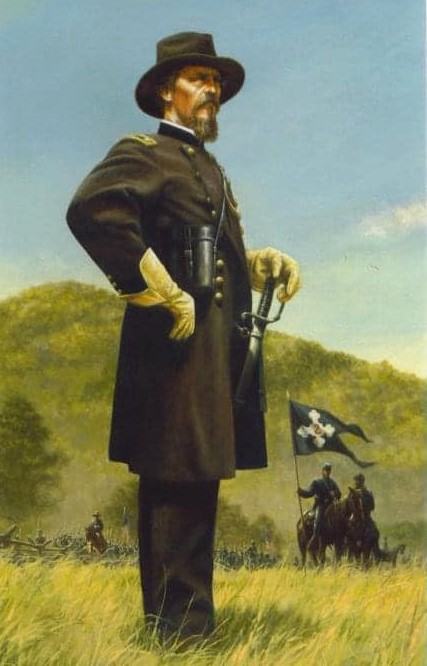
General Hancock at the Battle of Gettysburg, July 1863. “Hancock the Superb” — HERE.
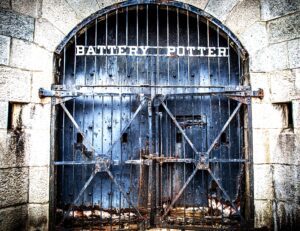
Battery Potter decaying iron entry gate at old Fort Hancock, March 2022. (Wayne Londregan Photo). The nation’s first disappearing gun battery on Sandy Hook was powered by a steam hydraulic-lift system. Construction began in 1890 and the gun was considered obsolete upon its finish in 1894. It was named in honor of Brigadier General Joseph H. Potter in March 1903.

Nike Hercules missiles at Fort Hancock in firing position, 1960s. Fort Hancock’s battery of guided-missiles could reach speeds of 1,700 mph in under 4 seconds while carrying conventional or Nuclear warheads. “Nike” was the Greek Goddess of victory. Douglas Aircraft designed the rockets: the Ajax and Hercules.
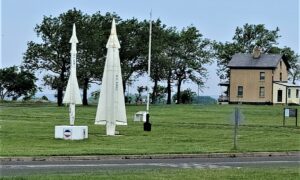
NIKE Missile historic display on Sandy Hook, 2021. When Installation was complete in July 1955, the fort had an operational anti-aircraft missile system. All top-secret, guarded 24/7 by dogs. Project Nike had been developed at Bell Labs in 1945. A 700-troop anti-aircraft battalion was included.
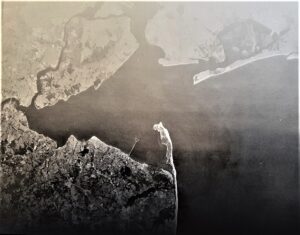
Sandy Hook area — a lot to protect in a 1950s world. The Army thought a Sandy Hook rocket base the ideal spot to guard the New York metro area. When installed in 1957, the dart-shaped Nike missile could hit a hostile aircraft up to 75 miles away. The supersonic weapon destroyed targets through use of an “electronic brain” and “radar eye.”
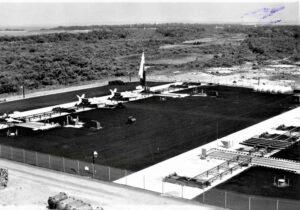
Nike Launch Area at Fort Hancock, 1959 (NPS Photo). The development of the Soviet ICBM doomed Project NIKE — by the late 1960s, deep cuts were underway for the air defense system. It was all deactivated in 1974. At Cold War heights, in 1962 more than 200 Nike sites surrounded America’s most important strategic cities defending against Communist aggression. These “Rings of Supersonic Steel” — a 2010 book calls them — were part of the US Army Air Defense Command. The Fort Hancock Nike Association hopes to rebuild these memories — HERE
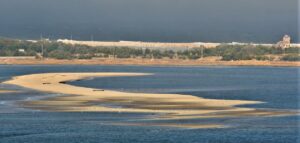
The tides at work on Sandy Hook, December 2021 (Dom J Manalo Photo).
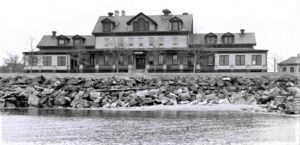
Post Hospital at Fort Hancock on Sandy Hook, 1950s. Designed by Stanford White in 1899, the building later became the Sandy Hook Marine Laboratory building. It burned in 1985.

Long Line — Fort Hancock Officer’s Row, 2021. Beginning in 1896, a total of 18 buff brick officer’s quarters were built along Sandy Hook Bay. Many still stand today although largely neglected.
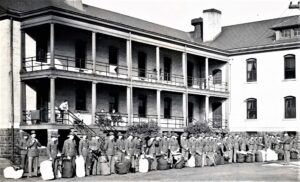
US Army troops at their Fort Hancock barracks, 1940. First garrisoned in March 1898, the fort was decommissioned in 1974.
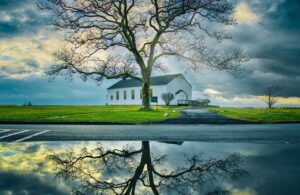
Old fort chapel on Sandy Hook (Al William Photo). Never looked prettier.
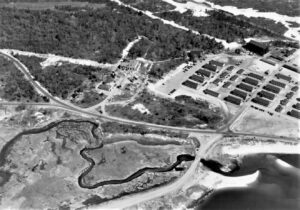
Fort Hancock on Sandy Hook, 1930s. In 1937, the fort became a test spot for the Signal Corps — leading the way to radar development.
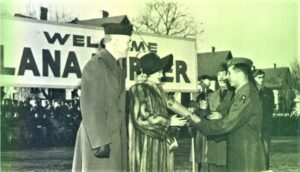
Movie star Lana Turner visits Fort Hancock soldiers on Sandy Hook, November 1941. A popular model and film actress, she died in 1995.
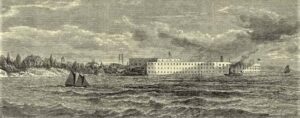
“New fort near Sandy Hook, at the entrance to the Bay of New York.” 1865 (N.Y. Public Library Photo).
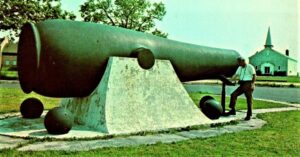
Rodman Gun at Fort Hancock on Sandy Hook, 1970s. The post chapel is in the background. The gun was developed by General Thomas Rodman for use in the Civil War. It was 115,00 pounds with a 20-inch muzzle.
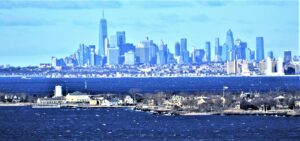
View from Mount Mitchill Scenic Overlook, Summer 2021. Sandy Hook is in foreground; NYC in background. At 266-feet above sea level, Mt. Mitchill is the highest natural point on North America’s eastern seaboard.
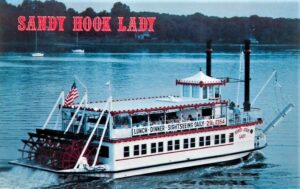
Sandy Hook Lady, built in 1991. The 65-foot, paddle-wheel boat held 125 passengers and offered cruises on the Shrewsbury and Navesink Rivers. The boat owners were charged with dumping raw sewage into the bay in 1996.
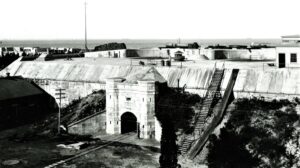
Battery Potter entrance at Fort Hancock, 1912. When completed in 1890, it was the first disappearing gun battery in the nation. By 1907, it was obsolete.
Video History of Sandy Hook, NJ by John Schneider — HERE
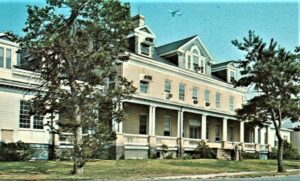
Old Sandy Hook Marine Laboratory, 1961. The building was taken by arson in September 1985 and later replaced by the James J. Howard Marine Sciences Laboratory.
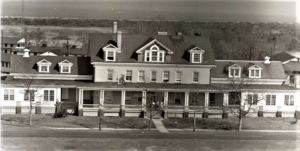
Old Sandy Hook Marine Laboratory building, 1969. Dr. Lionel A. Walford was the the lab’s first director. Designed by Stanford White in 1899, the building had been the post hospital.
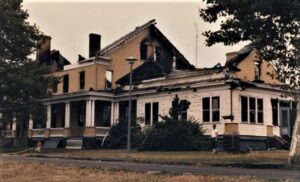
Old Sandy Hook Marine Laboratory building in ruins after fire, September 1985. The lab and years of scientific research were destroyed by arson.
Sandy Hook: Let It Be — HERE
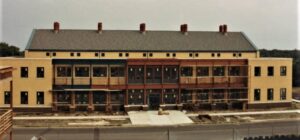
New James J. Howard Marine Sciences Laboratory nearing completion, 1992. The 35,000-square-foot, state-of-the-art marine research facility opened in October 1993 at a cost of $19 million. Congressman Howard served the area in the US House of Representatives for nearly 25 years; he died in 1988.
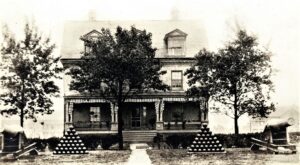
Fort Hancock Commanding Officer’s House, built in 1899. The US Army reached max at Sandy Hook during early World War II times when about 8,000 personnel military and civilian were stationed there.
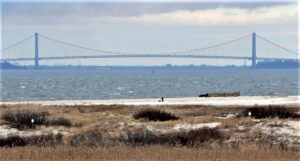
Verrazzano-Narrows Bridge seen from Sandy Hook, 2020. It’s 8 miles from the end of the hook to the bridge. The double-decked, 13-lane bridge opened in November 1964. Othmar Ammann was the designer. The 4,260-foot-long span connects the NYC boroughs of Staten Island and Brooklyn.
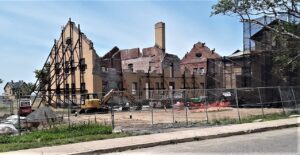
MAST’s new naval science buildings under construction/repair on Sandy Hook, June 2021. The Marine Academy of Science and Technology is part of the excellent Monmouth County Vocational School District. Opened in 1981 — it’s high school education at its finest. And too many county families are unaware of their free high caliber offerings. For more info.
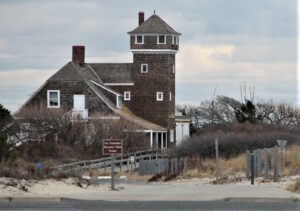
Old US Life-Saving Station at Sandy Hook, 2006. The nation’s first life-saving station was built on Sandy Hook in 1848.
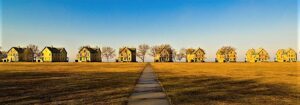
Officer’s Row at Fort Hancock, 2020 (Sandy Hook Rentals).
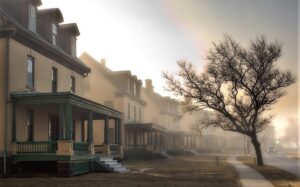
Officer’s Row at Fort Hancock, 2020 (Sandy Hook Rentals).
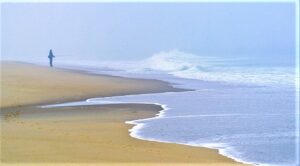
Fishing in the fog, 2020 (Sandy Hook Rentals).

“Sergent’s Row” at Fort Hancock. Housing for non-commissioned officers with families stationed on Sandy Hook.

National Park Service headquarters at Sandy Hook. Millions of people come to the national park to sun, swim, surf, boat, exercise, fish, and just relax.

Fire House No. 1 at Fort Hancock, 1940. The first of two firehouses built on the post opened in 1905.
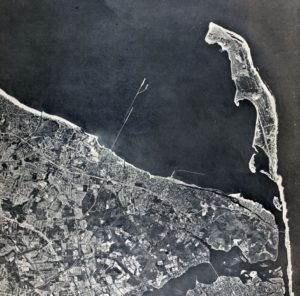
Sandy Hook satellite image, 1970s. The land is owned by the federal government and managed by the National Park Service as the Sandy Hook Unit of Gateway National Recreation Area.
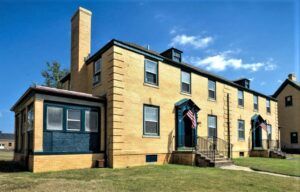
Sandy Hook’s first vacation rental is a historic home along Officer’s Row at Fort Hancock — MORE INFO

Battery Granger and gun crew, 1910. Built in 1897, its 10-inch gun could hit targets 8 miles out to sea.
More Info
• Historic Resource Study (1990): Gateway: Fort Hancock/1895-1948 — HERE
• Sandy Hook Proving Ground — HERE
• Fort Hancock Walking Tour — HERE
• Sandy Hook Foundation — HERE
